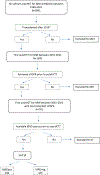Impact of pretransplant minimal residual disease in patients with multiple myeloma and a very good partial response or better receiving autologous hematopoietic stem cell transplantation
- PMID: 38127583
- PMCID: PMC11009063
- DOI: 10.1002/cncr.35171
Impact of pretransplant minimal residual disease in patients with multiple myeloma and a very good partial response or better receiving autologous hematopoietic stem cell transplantation
Abstract
Background: The prognostic significance of minimal residual disease (MRD) status before autologous hematopoietic stem cell transplantation (autoHCT) in patients with multiple myeloma (MM) has not been clearly elucidated.
Methods: Retrospective single-center study of adult MM patients who achieved ≥very good partial response (VGPR) after induction therapy from 2015 to 2021 received upfront autoHCT and had available pretransplant MRD status by next-generation flow cytometry. The cohort was divided into pretransplant MRD-negative (MRDneg) and MRD-positive (MRDpos) groups.
Results: A total of 733 patients were included in our analysis; 425 were MRDneg and 308 MRDpos at autoHCT. In the MRDpos group, more patients had high-risk cytogenetic abnormalities (48% vs. 38%, respectively; p = .025), whereas fewer patients achieved ≥CR before autoHCT (14% vs. 40%; p < .001). At day 100 after autoHCT, 37% of the MRDpos versus 71% of the MRDneg achieved ≥CR, and at best posttransplant response 65% versus 88% achieved ≥CR, respectively. After a median follow-up of 27.6 months (range, 0.7-82.3), the median PFS was significantly shorter for patients in the MRDpos group compared to the MRDneg group: 48.2 months (95% confidence interval [CI], 0.3-80.5) versus 80.1 months (95% CI, 0.5-80.1), respectively (p < .001). There was no significant difference in overall survival between the two groups (p = .41). Pretransplant MRDpos status was predictive of shorter PFS in multivariate analysis (hazard ratio, 1.80; 95% CI, 1.31-2.46; p < .001). The impact of pretransplant MRD status was retained in most of the examined subgroups.
Conclusions: In patients achieving ≥VGPR to induction, pretransplant MRDpos status was associated with a lower CR rate after autoHCT and a shorter PFS.
Keywords: autologous; minimal residual disease; multiple myeloma; transplantation.
© 2023 American Cancer Society.
Conflict of interest statement
Figures




Similar articles
-
Outcomes of Standard-Risk Multiple Myeloma Patients Who Undergo Upfront Autologous Hematopoietic Stem Cell Transplantation.Transplant Cell Ther. 2025 Mar;31(3):166.e1-166.e9. doi: 10.1016/j.jtct.2024.12.023. Epub 2024 Dec 31. Transplant Cell Ther. 2025. PMID: 39746546
-
Outcomes of Autologous Stem Cell Transplantation in Patients with Ultra-High-Risk Multiple Myeloma.Transplant Cell Ther. 2023 Dec;29(12):757-762. doi: 10.1016/j.jtct.2023.08.031. Epub 2023 Sep 4. Transplant Cell Ther. 2023. PMID: 37673125
-
Real-World Outcomes of Upfront Autologous Hematopoietic Stem Cell Transplantation in Patients With Newly Diagnosed Multiple Myeloma With Deletion 17p.Transplant Cell Ther. 2025 Jan;31(1):12.e1-12.e10. doi: 10.1016/j.jtct.2024.10.011. Epub 2024 Oct 22. Transplant Cell Ther. 2025. PMID: 39448031
-
Impact of residual disease as a prognostic factor for survival in women with advanced epithelial ovarian cancer after primary surgery.Cochrane Database Syst Rev. 2022 Sep 26;9(9):CD015048. doi: 10.1002/14651858.CD015048.pub2. Cochrane Database Syst Rev. 2022. PMID: 36161421 Free PMC article.
-
Autologous hematopoietic stem cell transplantation following high dose chemotherapy for non-rhabdomyosarcoma soft tissue sarcomas.Cochrane Database Syst Rev. 2013 Aug 7;2013(8):CD008216. doi: 10.1002/14651858.CD008216.pub4. Cochrane Database Syst Rev. 2013. Update in: Cochrane Database Syst Rev. 2017 Apr 13;4:CD008216. doi: 10.1002/14651858.CD008216.pub5. PMID: 23925699 Free PMC article. Updated.
Cited by
-
Autologous hematopoietic stem cell transplantation for multiple myeloma in the age of CAR T cell therapy.Front Oncol. 2024 Mar 27;14:1373548. doi: 10.3389/fonc.2024.1373548. eCollection 2024. Front Oncol. 2024. PMID: 38601770 Free PMC article. Review.
-
Real-World Evidence on Prognostic Value of MRD in Multiple Myeloma Using Flow Cytometry.Eur J Haematol. 2025 Jan;114(1):155-163. doi: 10.1111/ejh.14316. Epub 2024 Oct 10. Eur J Haematol. 2025. PMID: 39390851 Free PMC article.
-
Multiple myeloma patients with a long remission after autologous hematopoietic stem cell transplantation.Blood Cancer J. 2024 May 17;14(1):82. doi: 10.1038/s41408-024-01062-2. Blood Cancer J. 2024. PMID: 38760362 Free PMC article.
References
-
- Callander NS, Baljevic M, Adekola K, Anderson LD, Campagnaro E, Castillo JJ, et al. NCCN Guidelines(R) Insights: Multiple Myeloma, Version 3.2022. J Natl Compr Canc Netw. 2022;20(1):8–19. - PubMed
-
- Kumar S, Paiva B, Anderson KC, Durie B, Landgren O, Moreau P, et al. International Myeloma Working Group consensus criteria for response and minimal residual disease assessment in multiple myeloma. Lancet Oncol. 2016;17(8):e328–e46. - PubMed
-
- Harousseau JL, Avet-Loiseau H, Attal M, Charbonnel C, Garban F, Hulin C, et al. Achievement of at least very good partial response is a simple and robust prognostic factor in patients with multiple myeloma treated with high-dose therapy: long-term analysis of the IFM 99–02 and 99–04 Trials. J Clin Oncol. 2009;27(34):5720–6. - PubMed
Publication types
MeSH terms
Grants and funding
LinkOut - more resources
Full Text Sources
Medical

